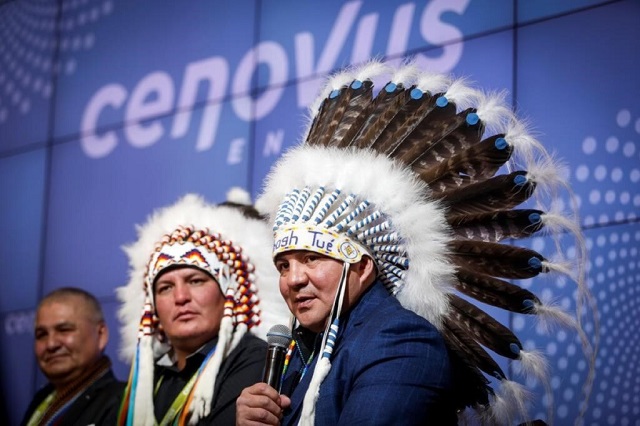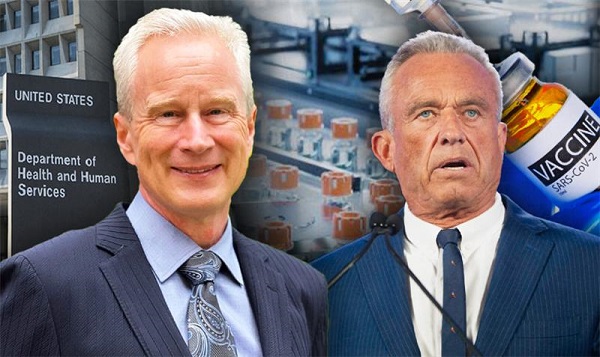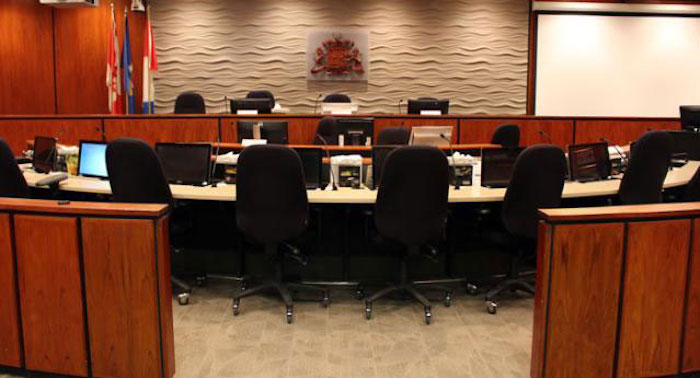Energy
A federally guaranteed Indigenous loan program is reconciliation progress, but only if it respects Indigenous agency

Roger Marten, right, Chief of Cold Lake First Nations, and Curtis Monias, centre, Chief of Heart Lake First Nation, speak after Cenovus CEO Alex Pourbaix announces an initiative focused on Indigenous communities. Photo from The Canadian Press.
From EnergyNow.ca
Indigenous communities are increasingly becoming partners and owners in major natural resource projects across the country.
Resource Works has been excited to be involved in that movement through our annual Indigenous Partnerships Success Showcase, where we convene Indigenous experts to discuss Indigenous partnerships in major projects and across the Canadian economy.
Under a proposed federal program, even more, Indigenous communities could become partners and even owners in major natural resource projects, from oil to natural gas and liquified natural gas (LNG).
Back in 2010, the proposed Northern Gateway oil pipeline from Alberta to Kitimat offered a 10% equity stake in the project to participating Indigenous groups. Yet despite having significant support, there was also considerable Indigenous opposition to the project. Ultimately, the project was killed when Prime Minister Trudeau banned oil tanker traffic on BC’s northern coast.
Fast forward twelve years, and the Coastal GasLink (CGL) natural gas pipeline and the LNG Canada project are nearing completion. In fact, CGL finished laying the last of its pipe in the ground in October 2023, completing a truly herculean engineering task, the first energy pipeline to the coast in decades. Despite some Indigenous opposition, CGL has the support of the elected councils of all 20 First Nations along the route and has offered an option for First Nations to purchase a 10% equity share in the pipeline.
Coastal GasLink will feed LNG Canada, the largest private sector investment in Canadian history. That project will turn CGL’s natural gas into liquid, where it can be shipped more densely to Asia to help replace coal, especially in industrial applications, and reduce global carbon emissions.
While CGL and LNG Canada near completion, two more proposals for LNG projects in BC are coming onto the scene. A historic first, these projects are led by First Nations: the Cedar LNG project near Kitimat from the Haisla Nation and Ksi Lisims LNG in Northern BC from the Nisga’a Nation.
A third LNG project, Woodfibre LNG, was approved by the Squamish Nation in the first-ever Indigenous environmental impact review and is now beginning construction.
Indigenous involvement – and leadership – in major energy projects has arrived. Indigenous LNG is Canadian LNG, and Canadian LNG has become Indigenous LNG. This is a global first.
Beyond natural gas and LNG, the Trans Mountain oil pipeline expansion project from Alberta to Burnaby is anticipating completion in March 2024. The expansion triples the pipeline’s capacity, the only oil pipeline to Canada’s West coast.
While there has been Indigenous opposition to this project, there has also been support, including formal agreements and billions in contracting deals for Indigenous businesses during construction. In fact, several Indigenous groups are working to acquire an equity stake in the pipeline.
Historic restrictions in the Indian Act mean Indigenous peoples face enormous barriers in raising or borrowing money to finance equity partnerships. Yet the ability to purchase equity in major projects is to enter the big leagues of economic development and wealth generation.
The federal government is expected to announce a guaranteed loan program that will enable Indigenous Peoples to finally bypass these structural obstacles and purchase equity shares in resource projects. Alberta and Saskatchewan already have their own programs, and the federal government has a lot to learn from them, particularly Alberta’s Alberta Indigenous Opportunities Corporation.
Supporters of such programs point out that Ottawa, without spending a cent of taxpayers’ money, could backstop loans to Indigenous communities. It’s a low-risk mechanism and another way to support economic reconciliation.
Unfortunately, there is uncertainty about whether this federal initiative will allow all projects to be supported. There are reports that Ottawa will exclude oil and gas projects from the guaranteed-loan program, in favour of exclusively renewable and green energy projects.
Indigenous groups argue that they can make up their own minds on what to invest in.
Four Indigenous groups have told the prime minister: “This program cannot be driven by an ‘Ottawa-knows-best’ policy approach – the judgement of Indigenous Nations about projects to pursue must be respected. . . . We believe that this initiative is not only a practical step towards reconciliation but an opportunity to demonstrate Canada’s commitment to a just future for First Peoples.”
If this loan program is created, it should be up to Indigenous peoples to decide what they want to get involved in. If we are in an era of reconciliation, shouldn’t we empower Indigenous Peoples to be decision-makers?
We can do big things as a country when we partner with Indigenous peoples. But we need to ground our policies in a positive framework that builds agency.
For many Indigenous peoples, that starts with charting their own economic destiny, including in natural resources.
Margareta Dovgal is Resource Works’ Managing Director and Event Lead for the Indigenous Partnerships Success Showcase
Energy
What does a Trump presidency means for Canadian energy?

From Resource Works
Heather-Exner Pirot of the Business Council of Canada and the Macdonald-Laurier Institute spoke with Resource Works about the transition to Donald Trump’s energy policy, hopes for Keystone XL’s revival, EVs, and more.
Do you think it is accurate to say that Trump’s energy policy will be the complete opposite of Joe Biden’s? Or will it be more nuanced than that?
It’s more nuanced than that. US oil and gas production did grow under Biden, as it did under Obama. It’s actually at record levels right now. The US is producing the most oil and gas per day that any nation has ever produced in the history of the world.
That said, the federal government in the US has imposed relatively little control over production. In the absence of restrictive emissions and climate policies that we have in Canada, most of the oil production decisions have been made based on market forces. With prices where they’re at currently, there’s not a lot of shareholder appetite to grow that significantly.
The few areas you can expect change: leasing more federal lands and off shore areas for oil and gas development; rescinding the pause in LNG export permits; eliminating the new methane fee; and removing Biden’s ambitious vehicle fuel efficiency standards, which would subsequently maintain gas demand.
I would say on nuclear energy, there won’t be a reversal, as that file has earned bipartisan support. If anything, a Trump Admin would push regulators to approve SMRs models and projects faster. They want more of all kinds of energy.
Is Keystone XL a dead letter, or is there enough planning and infrastructure still in-place to restart that project?
I haven’t heard any appetite in the private sector to restart that in the short term. I know Alberta is pushing it. I do think it makes sense for North American energy security – energy dominance, as the Trump Admin calls – and I believe there is a market for more Canadian oil in the USA; it makes economic sense. But it’s still looked at as too politically risky for investors.
To have it move forward I think you would need some government support to derisk it. A TMX model, even. And clear evidence of social license and bipartisan support so it can survive the next election on both sides of the border.
Frankly, Northern Gateway is the better project for Canada to restart, under a Conservative government.
Keystone XL was cancelled by Biden prior to the invasion of Ukraine in 2022. Do you think that the reshoring/friendshoring of the energy supply is a far bigger priority now?
It absolutely is a bigger priority. But it’s also a smaller threat. You need to appreciate that North America has become much more energy independent and secure than it has ever been. Both US and Canada are producing at record levels. Combined, we now produce more than the Middle East (41 million boe/d vs 38 million boe/d). And Canada has taken a growing share of US imports (now 60%) even as their import levels have declined.
But there are two risks on the horizon: the first is that oil is a non renewable resource and the US is expected to reach a peak in shale oil production in the next few years. No one wants to go back to the days when OPEC + had dominant market power. I think there will be a lot of demand for Canadian oil to fill the gap left by any decline in US oil production. And Norway’s production is expected to peak imminently as well.
The second is the need from our allies for LNG. Europe is still dependent on Russia for natural gas, energy demand is growing in Asia, and high industrial energy costs are weighing on both. More and cheaper LNG from North America is highly important for the energy security of our allies, and thus the western alliance as it faces a challenge from Russia, China and Iran.
Canada has little choice but to follow the US lead on many issues such as EVs and tariffs on China. Regarding energy policy, does Canada’s relative strength in the oil and gas sector give it a stronger hand when it comes to having an independent energy policy?
I don’t think we want an independent energy policy. I would argue we both benefit from alignment and interdependence. And we’ve built up that interdependence on the infrastructure side over decades: pipelines, refineries, transmission, everything.
That interdependence gives us a stronger hand in other areas of the economy. Any tariffs on Canadian energy would absolutely not be in American’s interests in terms of their energy dominance agenda. Trump wants to drop energy costs, not hike them.
I think we can leverage tariff exemptions in energy to other sectors, such as manufacturing, which is more vulnerable. But you have to make the case for why that makes sense for US, not just Canada. And that’s because we need as much industrial capacity in the west as we can muster to counter China and Russia. America First is fine, but this is not the time for America Alone.
Do you see provinces like Alberta and Saskatchewan being more on-side with the US than the federal government when it comes to energy?
Of course. The North American capital that is threatening their economic interests is not Washington DC; it’s Ottawa.
I think you are seeing some recognition – much belated and fast on the heels of an emissions cap that could shut in over 2 million boe of production! – that what makes Canada important to the United States and in the world is our oil and gas and uranium and critical minerals and agricultural products.
We’ve spent almost a decade constraining those sectors. There is no doubt a Trump Admin will be complicated, but at the very least it’s clarified how important those sectors are to our soft and hard power.
It’s not too late for Canada to flex its muscles on the world stage and use its resources to advance our national interests, and our allies’ interests. In fact, it’s absolutely critical that we do so.
Energy
What Will Be the Future of the Keystone XL Pipeline Under President Trump?

From EnergyNow.ca
By Terry Winnitoy, EnergyNow
The Keystone XL Pipeline, proposed in 2008, was designed to transport Canadian crude oil from Alberta to refineries in the United States, specifically to Steele City, Nebraska, and onward to refineries in Illinois and Texas, as well as to an oil pipeline distribution center in Cushing, Oklahoma.
Spanning approximately 1,179 miles and designed to transport up to 830,000 barrels of oil per day, the pipeline promised significant economic and energy security benefits. However, it became a focal point of political and environmental controversy, leading to its eventual cancellation by Presidents Obama and Biden.
Here’s a brief look at its history, the reasons it should have been built, the political dynamics that led to its cancellation and will President-elect Trump revive it?
Why the Keystone XL Pipeline Should Have Been Built
Economic and Job Creation
The pipeline was projected to create thousands of construction jobs and several hundred permanent jobs, providing a significant boost to the economy. It was also expected to stimulate economic activity through the development of related infrastructure and services.
Energy Security
By facilitating the efficient transport of a large volume of oil from a stable and friendly neighboring country, the pipeline would have reduced American dependence on oil imports from more volatile regions, enhancing national energy security.
Environmental Safety
Pipelines are generally safer and more environmentally friendly for transporting oil compared to rail or truck, with lower risks of spills and accidents. The Keystone XL was designed with the latest technology to minimize leaks and environmental impact.
Regulatory Oversight
The project underwent extensive environmental reviews and was subject to strict regulatory standards to ensure it adhered to environmental protection and safety measures.
Political Reasons for Cancellation
Environmental Activism
The pipeline became a symbol for environmentalists who opposed further development of fossil fuel infrastructure. They argued it would contribute to climate change by enabling the extraction and consumption of oil sands, which are more carbon-intensive than other oil sources.
Obama’s Cancellation
President Obama rejected the pipeline in 2015, citing environmental concerns and its potential impact on global climate change. He argued that approving the pipeline would have undercut America’s leadership on climate change.
Trump’s Reversal and Biden’s Final Cancellation
President Trump revived the project in 2017, citing economic benefits and energy security. However, President Biden canceled it again on his first day in office in 2021, fulfilling a campaign promise to prioritize climate change issues and transition towards renewable energy.
Political Symbolism
For both Obama and Biden, the decision to cancel the Keystone XL Pipeline was also a symbolic gesture, demonstrating a commitment to environmental sustainability and a shift away from fossil fuel dependence in line with their administrations’ climate policies.
Will President-Elect Trump Reinstate It?
Currently, there is no definitive answer on whether President-elect Trump will reinstate the Keystone XL Pipeline. His previous administration showed support for the project, citing its potential economic and energy security benefits. However, reinstating the pipeline would require navigating significant political, legal, and environmental challenges that have developed over the years.
It would also depend on the current geopolitical, economic, and environmental priorities at the time of his taking office. The Keystone XL Pipeline’s history is a complex tapestry of economic aspirations, environmental concerns, and political maneuvers.
Its cancellation has been a contentious issue, reflecting the broader national and global debates over energy policy and climate change strategy. Whether it will be reinstated remains a significant question, contingent on a multitude of factors including political will, environmental policies, and market dynamics.
That all said, re-instating its approval might be the perfect “in your face” moment for Trump to Obama and Biden as he begins his second term of presidency. We’ll have to wait and see.
-

 Brownstone Institute2 days ago
Brownstone Institute2 days agoThe Most Devastating Report So Far
-

 Business2 days ago
Business2 days agoCarbon tax bureaucracy costs taxpayers $800 million
-

 ESG1 day ago
ESG1 day agoCan’t afford Rent? Groceries for your kids? Trudeau says suck it up and pay the tax!
-

 Daily Caller1 day ago
Daily Caller1 day agoLos Angeles Passes ‘Sanctuary City’ Ordinance In Wake Of Trump’s Deportation Plan
-

 John Stossel1 day ago
John Stossel1 day agoGreen Energy Needs Minerals, Yet America Blocks New Mines
-

 COVID-192 days ago
COVID-192 days agoDr. McCullough praises RFK Jr., urges him to pull COVID shots from the market
-

 Alberta1 day ago
Alberta1 day agoProvince considering new Red Deer River reservoir east of Red Deer
-

 MAiD2 days ago
MAiD2 days agoOver 40% of people euthanized in Ontario lived in poorest parts of the province: government data





